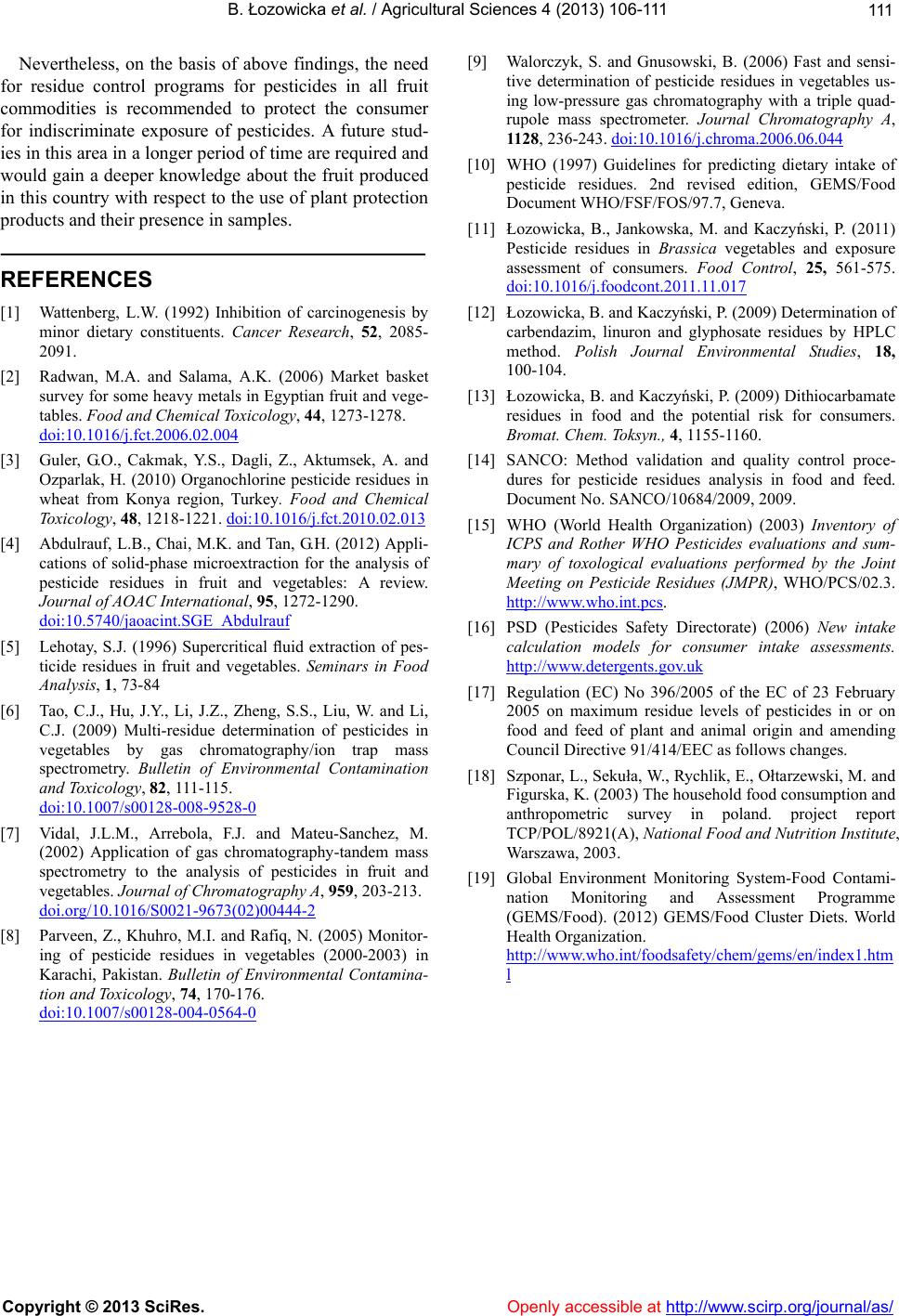
B. Łozowicka et al. / Agricultural Sciences 4 (2013) 106-111
Copyright © 2013 SciRes. http://www.scirp.org/journal/as/
111
[9] Walorczyk, S. and Gnusowski, B. (2006) Fast and sensi-
tive determination of pesticide residues in vegetables us-
ing low-pressure gas chromatography with a triple quad-
rupole mass spectrometer. Journal Chromatography A,
1128, 236-243. doi:10.1016/j.chroma.2006.06.044
Nevertheless, on the basis of above findings, the need
for residue control programs for pesticides in all fruit
commodities is recommended to protect the consumer
for indiscriminate exposure of pesticides. A future stud-
ies in this area in a longer period of time are required and
would gain a deeper knowledge about the fruit produced
in this country with respect to the use of plant protection
products and their presence in samples.
[10] WHO (1997) Guidelines for predicting dietary intake of
pesticide residues. 2nd revised edition, GEMS/Food
Document WHO/FSF/FOS/97.7, Geneva.
[11] Łozowicka, B., Jankowska, M. and Kaczyński, P. (2011)
Pesticide residues in Brassica vegetables and exposure
assessment of consumers. Food Control, 25, 561-575.
doi:10.1016/j.foodcont.2011.11.017
REFERENCES
[1] Wattenberg, L.W. (1992) Inhibition of carcinogenesis by
minor dietary constituents. Cancer Research, 52, 2085-
2091.
[12] Łozowicka, B. and Kaczyński, P. (2009) Determination of
carbendazim, linuron and glyphosate residues by HPLC
method. Polish Journal Environmental Studies, 18,
100-104.
[2] Radwan, M.A. and Salama, A.K. (2006) Market basket
survey for some heavy metals in Egyptian fruit and vege-
tables. Food and Chemical Toxicology, 44, 1273-1278.
doi:10.1016/j.fct.2006.02.004
[13] Łozowicka, B. and Kaczyński, P. (2009) Dithiocarbamate
residues in food and the potential risk for consumers.
Bromat. Chem. Toksyn., 4, 1155-1160.
[3] Guler, G.O., Cakmak, Y.S., Dagli, Z., Aktumsek, A. and
Ozparlak, H. (2010) Organochlorine pesticide residues in
wheat from Konya region, Turkey. Food and Chemical
Toxicology, 48, 1218-1221. doi:10.1016/j.fct.2010.02.013
[14] SANCO: Method validation and quality control proce-
dures for pesticide residues analysis in food and feed.
Document No. SANCO/10684/2009, 2009.
[15] WHO (World Health Organization) (2003) Inventory of
ICPS and Rother WHO Pesticides evaluations and sum-
mary of toxological evaluations performed by the Joint
Meeting on Pesticide Residues (JMPR), WHO/PCS/02.3.
http://www.who.int.pcs.
[4] Abdulrauf, L.B., Chai, M.K. and Tan, G.H. (2012) Appli-
cations of solid-phase microextraction for the analysis of
pesticide residues in fruit and vegetables: A review.
Journal of AOAC International, 95, 1272-1290.
doi:10.5740/jaoacint.SGE_Abdulrauf [16] PSD (Pesticides Safety Directorate) (2006) New intake
calculation models for consumer intake assessments.
http://www.detergents.gov.uk
[5] Lehotay, S.J. (1996) Supercritical fluid extraction of pes-
ticide residues in fruit and vegetables. Seminars in Food
Analysis, 1, 73-84 [17] Regulation (EC) No 396/2005 of the EC of 23 February
2005 on maximum residue levels of pesticides in or on
food and feed of plant and animal origin and amending
Council Directive 91/414/EEC as follows changes.
[6] Tao, C.J., Hu, J.Y., Li, J.Z., Zheng, S.S., Liu, W. and Li,
C.J. (2009) Multi-residue determination of pesticides in
vegetables by gas chromatography/ion trap mass
spectrometry. Bulletin of Environmental Contamination
and Toxicology, 82, 111-115.
doi:10.1007/s00128-008-9528-0
[18] Szponar, L., Sekuła, W., Rychlik, E., Ołtarzewski, M. and
Figurska, K. (2003) The household food consumption and
anthropometric survey in poland. project report
TCP/POL/8921(A), National Food and Nutrition Institute,
Warszawa, 2003.
[7] Vidal, J.L.M., Arrebola, F.J. and Mateu-Sanchez, M.
(2002) Application of gas chromatography-tandem mass
spectrometry to the analysis of pesticides in fruit and
vegetables. Journal of Chromatography A, 959, 203-213.
doi.org/10.1016/S0021-9673(02)00444-2
[19] Global Environment Monitoring System-Food Contami-
nation Monitoring and Assessment Programme
(GEMS/Food). (2012) GEMS/Food Cluster Diets. World
Health Organization.
http://www.who.int/foodsafety/chem/gems/en/index1.htm
l
[8] Parveen, Z., Khuhro, M.I. and Rafiq, N. (2005) Monitor-
ing of pesticide residues in vegetables (2000-2003) in
Karachi, Pakistan. Bulletin of Environmental Contamina-
tion and Toxicology, 74, 170-176.
doi:10.1007/s00128-004-0564-0
Openly accessible at